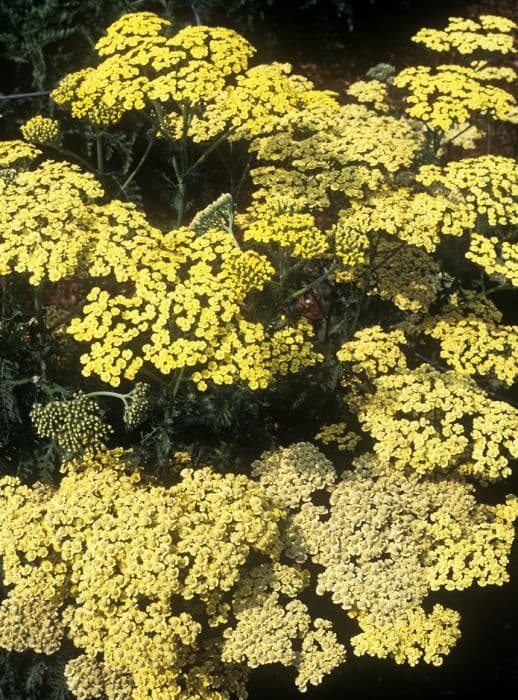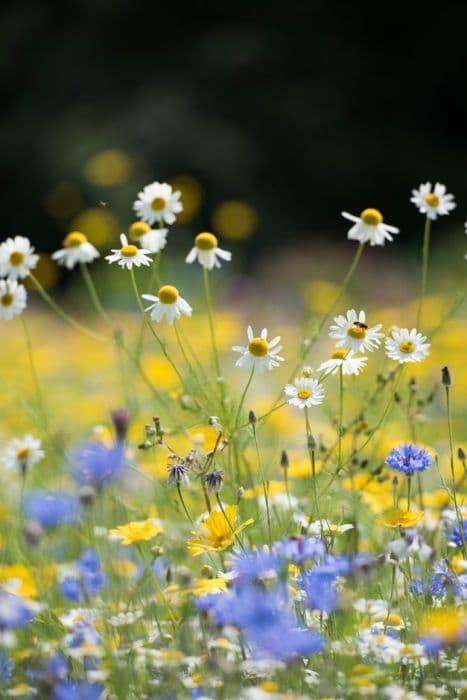Cornflower Centaurea cyanus

ABOUT
The plant commonly known as Cornflower is characterized by its striking blue flowers, which have a frilly, starburst appearance. These vivid blooms consist of a clustered head surrounded by slightly spikey petals, often in bright shades of blue but can also be found in pink, white, and purple variations. The center of each flower head is typically darker, with a tubular structure that's surrounded by the more extended, lance-shaped petals. The foliage of the Cornflower is lanceolate to linear, with a grey-green to blue-green color. The leaves are slender and somewhat long, giving the plant a delicate and fine-textured look. They may have a slightly fuzzy texture, which is common among plants in its family. The stems of the Cornflower are slender but sturdy, with a branched appearance that allows for multiple flowers to blossom from a single plant. As it grows, the Cornflower can develop a bushy habit, with the foliage and flowers creating an attractively dense cluster, which can be visually appealing in a garden setting or when grown as part of a wildflower mix. The intense blue of its flowers makes it a favorite among gardeners and flower enthusiasts for its ability to add a splash of color to any landscape. The plant may produce a generous quantity of flowers under ideal conditions. These flowers are not only a visual delight but are also known to attract various pollinators, including bees and butterflies, contributing to the health of the ecosystem in which they are planted. Despite its delicate appearance, Cornflower is known for its hardiness and ability to withstand a range of conditions once it is established.
About this plant
 Names
NamesSynonyms
Bachelor's Button, Cornflower, Bluebottle, Boutonniere Flower, Hurtsickle, Cyani Flower.
Common names
Cyanus segetum, Centaurea segetum, Centaurea cyanus var. nemoralis, Centaurea cyanus var. suffulta, Centaurea montana, Centaurea pratensis, Cyanus montanus, Cyanocephalus montanus, Jacea montana, Cyanocephalus pratensis.
 Toxicity
ToxicityTo humans
Cornflower, the most common name for Centaurea cyanus, is not generally considered toxic to humans. There are no well-documented cases of poisoning from ingesting parts of this plant. However, as with any non-food plant, individual allergies or sensitivities can occur, and it is advised to use caution and not consume plants that are not typically recognized as food.
To pets
Cornflower, or Centaurea cyanus, is not commonly known to be toxic to pets such as dogs and cats. No significant toxic effects have been reported in pets consuming this plant. Nonetheless, pet owners should always be cautious and prevent their pets from eating ornamental plants, as individual animals might have different sensitivities or reactions. If a pet is known to have ingested significant amounts of cornflower, it is best to consult a veterinarian, especially if any adverse reactions are noticed.
 Characteristics
CharacteristicsLife cycle
Annuals
Foliage type
Deciduous
Color of leaves
Green
Flower color
Blue
Height
1-3 feet (30-90 cm)
Spread
1-2 feet (30-60 cm)
Plant type
Herb
Hardiness zones
2-11
Native area
Europe
Benefits
 General Benefits
General Benefits- Erosion Control: The roots of Cornflower can help stabilize soil and prevent erosion.
- Attracting Pollinators: Cornflower is known to attract bees, butterflies, and other pollinating insects, which are essential for the pollination of many crops and plants.
- Aesthetic Value: With its bright blue flowers, Cornflower can add beauty and color to gardens and landscapes, enhancing visual interest.
- Companion Planting: Gardeners often use Cornflower in companion planting to benefit surrounding plants and create a biodiverse environment.
- Wildlife Habitat: By providing nectar and pollen, Cornflower can serve as a food source for various species of wildlife.
- Culinary Uses: The petals of Cornflower are sometimes used as a natural food coloring or as an edible garnish in salads and other dishes.
- Dye Production: Historically, the blue pigment from Cornflower has been used in dyes for fabrics.
 Medical Properties
Medical Properties- Anti-inflammatory: Centaurea cyanus, commonly known as cornflower, is traditionally used for its potential to reduce inflammation.
- Astringent: The plant has been used for its astringent properties to help tighten the skin and relieve irritation.
- Diuretic: Cornflower has been used to promote urination which can help in the removal of excess fluids from the body.
- Ophthalmic: There is historical use of cornflower water as an eye wash to soothe tired and irritated eyes.
- Choleretic: Cornflower is thought to stimulate the liver to produce bile, which can aid digestion.
 Air-purifying Qualities
Air-purifying QualitiesThis plant is not specifically known for air purifying qualities.
 Other Uses
Other Uses- As a natural fabric dye: The Cornflower can be used to dye fabrics blue, though the color may vary depending on the mordant used.
- In culinary decoration: Cornflower petals add a splash of vibrant blue color to salads, desserts, and cocktails for an elegant presentation.
- As a feature in historical ceremonies: In some cultures, Cornflower petals have been tossed as part of harvest celebrations and other traditional festivities.
- In the cosmetic industry: Cornflower extracts are sometimes used in eye shadows, blushes, and other makeup products for their natural hue.
- As an addition to potpourris: Dried Cornflower petals can be included in homemade potpourris to add color and a light, floral fragrance to a room.
- For floral arts and crafts: Cornflower petals and stems are used in the creation of natural jewelry, pressed flower art, and decorative wreaths.
- In photography and film: Cornflowers often serve as the perfect natural setting or prop to create a visually appealing scene due to their vibrant color.
- As an eco-friendly confetti: Dried Cornflower petals are biodegradable, making them an environmentally friendly alternative to synthetic confetti at celebrations.
- For educational purposes: Cornflowers can be used in botany and ecology classes to teach about plant life cycles, pollination, and biodiversity.
- As an ingredient in crafts, such as homemade soaps: The petals of the Cornflower may be embedded in soaps for exfoliation and visual appeal.
Interesting Facts
 Feng Shui
Feng ShuiThe Cornflower is not used in Feng Shui practice.
 Zodiac Sign Compitability
Zodiac Sign CompitabilityThe Cornflower is not used in astrology practice.
 Plant Symbolism
Plant Symbolism- Love and Devotion: Centaurea cyanus, commonly known as Cornflower, is traditionally associated with feelings of love and devotion. Giving someone this flower may indicate deep feelings and an unwavering dedication to the person receiving it.
- Fertility and Fortune: In some folklore, Cornflowers are believed to symbolize fertility and bring good fortune, making them a positive emblem for those wishing for abundance or the growth of their family.
- Innocence and Purity: The delicate and bright blue color of the Cornflower often represents innocence and purity, reminiscent of a clear summer sky.
- Hope in Love: Cornflowers are sometimes given as a token of hope in love or to express a wish for someone’s happiness in their romantic endeavors.
- Royalty: Due to its vivid blue hue, the Cornflower is also associated with royalty and might be used to represent noble beauty or grace.
- Remembrance: In some cultures, the Cornflower is a symbol of remembrance. It is particularly known as a flower worn to honor fallen soldiers, akin to the red poppy, in countries like France and Germany.
 Water
WaterThe common name for Centaurea cyanus is Bachelor's button. To maintain optimal moisture, water Bachelor's buttons thoroughly once a week, providing about 1 gallon of water per square yard of soil, which allows the water to penetrate deeply into the root zone. During periods of extreme heat or dryness, increase the frequency to twice a week, ensuring the soil never becomes completely dry but is also not consistently soggy, which can lead to root rot. Decrease watering to every other week when the plant is not in its active growing season or during cooler, wetter weather to prevent overwatering.
 Light
LightBachelor's button thrives best in full sunlight, meaning the plant should receive at least 6 to 8 hours of direct sunlight each day. An ideal spot for Bachelor's buttons would be an unobstructed location where they are exposed to the morning sun and protected from intense afternoon heat if the climate is particularly hot. However, they can also tolerate some light shade, especially in areas with very strong sun.
 Temperature
TemperatureBachelor's buttons are hardy in a wide range of temperatures and can survive in temperatures as low as 0°F and as high as 90°F, but they grow best in temperate conditions between 60°F to 75°F. During the winter months, they can survive a freeze, but prolonged periods of extreme cold or heat can be detrimental to the plant.
 Pruning
PruningPruning Bachelor's buttons involve deadheading spent blooms to promote further flowering and maintaining the plant's shape. The best time to prune is in late summer or early fall after the plant has finished most of its blooming. Regular pruning every few weeks during the blooming season can also help encourage continuous flower production. Cut back the plant by about one-third in the fall to prepare it for winter and to encourage robust growth in the spring.
 Cleaning
CleaningAs needed
 Soil
SoilCornflower prefers well-drained soil with a pH between 6.0 and 7.5. A mix of garden soil, compost, and a bit of sand for improved drainage works well. Ensuring organic matter content will contribute to overall plant health.
 Repotting
RepottingCornflowers, being annuals, do not generally require repotting. Plant them in-ground or in a suitable container where they can grow for the season without the need for repotting.
 Humidity & Misting
Humidity & MistingCornflower thrives in average humidity conditions. They do not require high humidity, making them suitable for most natural outdoor environments.
 Suitable locations
Suitable locationsIndoor
Use well-draining soil and place in a sunny spot.
Outdoor
Plant in full sun, well-drained soil, and space adequately.
Hardiness zone
3-8 USDA
 Life cycle
Life cycleThe life cycle of Centaurea cyanus, commonly known as Cornflower or Bachelor's button, begins with seed germination which typically occurs in spring when soil temperatures warm up. Upon germination, it develops a rosette of leaves at the soil surface. As the plant matures, it elongates to form a flowering stem, a process known as bolting. Flower buds form and eventually bloom into the characteristic blue flowers that are often associated with the species. Cornflower is an annual, so after flowering, the plant sets seeds and then completes its life cycle. The seeds are then dispersed by various means, including wind and animals, to begin the cycle anew in the next growing season.
 Propogation
PropogationPropogation time
Spring-Early Summer
Propogation: The most popular method of propagating Cornflower, or Centaurea cyanus, is by seed. Planting time for seeds is typically in the spring, after the last frost has passed, or in the fall where winters are mild. To propagate, sow the seeds directly into a well-draining soil at a depth of about 1/4 inch (6.35 millimeters), lightly covering them with soil. Seeds require adequate sunlight to germinate, so they should not be buried too deeply. Watering should be done gently to keep the soil moist without causing the seeds to wash away. Germination usually occurs within 7 to 14 days in temperatures between 60°F to 70°F (15°C to 21°C), after which seedlings will begin to grow and can be thinned out to prevent overcrowding. This method is simple and effective, resulting in vibrant blooms that can enhance the garden in the following summer.









